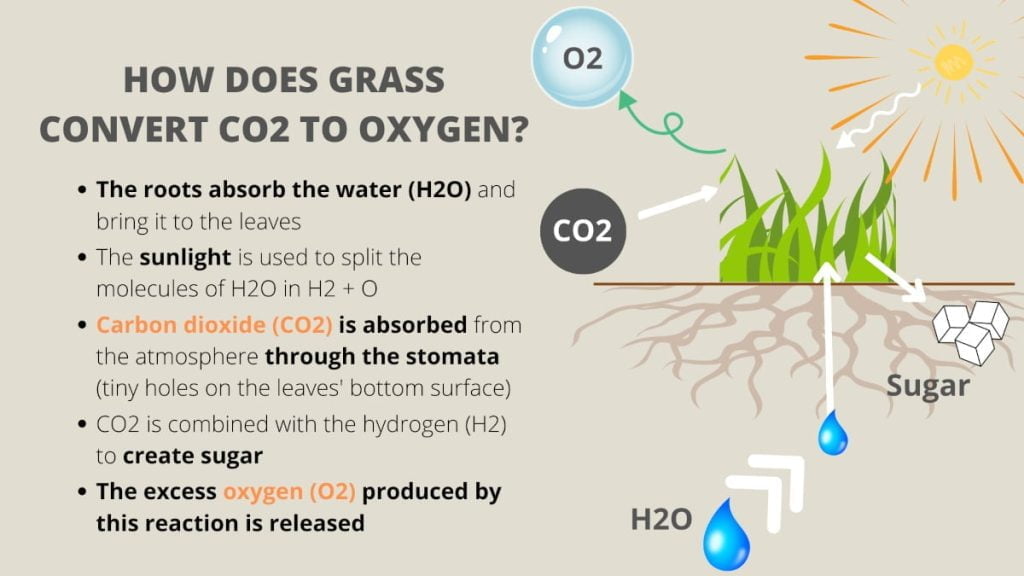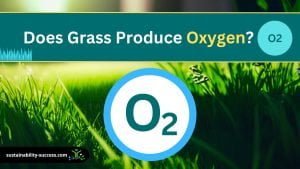Yes, grass is one of the plants that produce oxygen through the process of photosynthesis. During this process, the chlorophyll in the plant’s cells absorbs energy from sunlight and carbon dioxide from the air. The energy is then used to convert carbon dioxide and water into glucose and oxygen.
Key Takeaways
- Grass produces oxygen through photosynthesis, more efficiently than trees.
- A 5,000 sq ft lawn can produce enough oxygen for up to 35 people.
- Grass contributes to environmental benefits like cooling, preventing soil erosion, and improving air quality.
The amount of oxygen produced by the grass varies depending on the amount of chlorophyll the plant contains. However, it’s interesting to know that some marine organisms produce more oxygen than terrestrial plants.
How much oxygen does grass produce?
A lawn can produce significant amounts of oxygen, in fact, studies show that one 5,000 sq ft of grassland can produce enough oxygen for up to 35 people!
How much oxygen does grass produce compared to trees?
It’s a lesser-known fact that grass, the often-overlooked green foliage lining the Earth’s surfaces, plays a crucial role in producing oxygen for our environment. And guess what? A lawn produces oxygen at a rate greater than trees!
Studies show that while 5,000 sq ft of trees with full canopy coverage produces enough oxygen for between 8 and 18 people, the same area covered in grass produces enough for almost 35 people! That’s a significant difference.
When it comes to carbon sequestration, planting trees often comes to mind. Yet, grass plays a crucial role in absorbing carbon dioxide from the air and releasing oxygen through the process of photosynthesis.
Here’s how gras vs trees compare for oxygen production:
- Grass is more efficient than trees in producing oxygen because it can grow much faster. When a plant grows, it is storing CO2 and releasing oxygen, so the faster it grows, the more oxygen it produces.
- Trees have a longer lifespan and can store more carbon over time.
So, next time you’re enjoying a picnic on a vibrant green lawn, remember that you’re also benefiting from the fresh oxygen it’s producing. And it’s not just the oxygen coming from the trees that are helping improve air quality; the oxygen-producing ability of grass is not one to be underestimated!
The Process of Photosynthesis

Photosynthesis is the biochemical process by which plants convert light energy into chemical energy. In grass, photosynthesis occurs mainly in its leaves, which contain pigment molecules called chlorophyll.
Chlorophyll absorbs light from the sun and uses its energy to convert carbon dioxide and water into glucose and oxygen. This process releases oxygen into the air and is crucial to the survival of humans and animals.
Chlorophyll is also what makes grass green, check it out here!
Does grass breathe?
No, grass does not breathe like humans do. However, it does perform photosynthesis, a process that involves taking in carbon dioxide and releasing oxygen. Sometimes this process of absorbing CO2 and releasing oxygen may be referred to as “breathing” for plants.
Environmental Benefits of Grass
Having a beautiful lawn is not just a landscaping feature and the benefits of grass as a source of oxygen go beyond human health. Let’s talk about the environment and how the grass interacts with it!
Cooling and Heat Retention
- Grass serves as a natural cooler, not just for hot summer days but year-round.
- The blades of grass help reflect sunlight back into the atmosphere, reducing the amount retained and radiated by the surface.
This capacity to reflect sunlight not only cools the environment but has a significant role in mitigating the heat island effect that cities experience. In cities, the ratio of heat-absorbing surfaces to grass and plant-covered ones is higher.
That’s why cities have a higher temperature than their rural counterparts and why green areas are fundamental architectural aspect in cities. The heat island effect is in part caused by lower grass coverage.
Preventing Soil Erosion
Grasses are notorious for their root systems, which can be ten times their size above ground. This length and density make grass one of the best plants for erosion control.
Utilized along shorelines, hillsides, and other high erosion areas, grasses’ underground systems help hold in the soil, and by doing so, prevent heavy runoff from rainfall.
Air quality
A lawn filled with grass can provide a significant amount of oxygen, improve air quality and environmental sustainability.
Soil quality
Grass doesn’t just produce oxygen, in fact, it can also improve soil quality by breaking down pollutants, improving water retention and providing nutrients for other plants and trees.
Health Benefits of Increased Oxygen Supply through Grass
Breathing fresh air can lead to numerous health benefits, including better sleep, improved cognitive function, and reduced stress levels. Increased oxygen levels in the air can have a positive impact on our overall health and well-being.
Finally, greenery enhances the appeal of outdoor spaces, which can encourage physical activities, improve mental health and enhance the quality of life. That’s one of the reasons why green areas also improve social interactions.
Lifespan of Grass
Grass typically has a lifespan of around 5 to 8 years, depending on the type of grass and environmental factors. The longer the lifespan, the more oxygen the grass produces.
Therefore, taking care of grass by regular maintenance, such as proper watering and fertilization, can lead to denser and longer-lasting grass that produces more oxygen.
Conclusion
There you have it! Yes, grass does produce oxygen! But don’t be tricked into thinking that your lawn is solely responsible for keeping our planet’s oxygen levels up.
Marine life, such as algae, actually produces more oxygen than plants on land. And let’s not forget about all the other plants out there that also contribute to oxygen production.
But don’t underestimate the power of grass! Your backyard may not be a giant oxygen factory, but every bit helps. So go ahead and take a deep breath of fresh air, courtesy of the grass beneath your feet.

